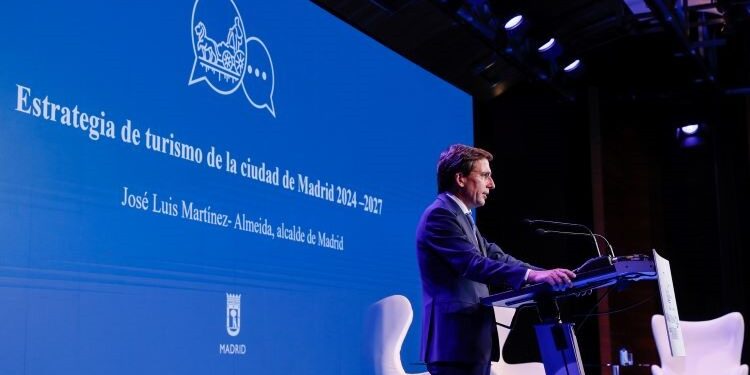The Diplomat
The mayor of Madrid, José Luis Martínez-Almeida, has explained that the conceptual framework that will govern the city’s Strategic Tourism Plan 2024-2027 will be articulated around three strategic lines based on “redefinition, model regeneration and redistribution”, with the objective to achieve two fundamental ideas: “we do not want to be a fad and we do not want to die of success.“
The mayor of the capital presented the initiative yesterday during the II Tourism Forum of the city of Madrid that took place at the Meliá Castilla under the motto ‘Let’s promote Madrid as a sustainable urban destination. Redefine, redistribute and regenerate.
Specifically, it is a roadmap prepared by the Delegated Area of Tourism, in coordination with the Madrid tourism sector, which will guide the capital’s strategy in the medium and long term to continue promoting the tourism leadership of the Madrid destination under these three backbone principles.
Redefinition, Almeida pointed out, to detect the potential of the city, with strengths such as leisure, culture and sports alternatives, and acting on weaknesses it may have, with actions such as improving the connectivity of Barajas or implementing indicators not focused solely on values such as number of visitors or economic impact but expanded to issues such as satisfaction or sustainability to have a “complete diagnosis” and be able to maintain the good momentum of the city as a tourist destination.
The second pillar, regeneration, to adapt to a changing world in which expectations and ambitions are different and require different capabilities. He indicated as points of action in this sense such as achieving improved infrastructure, new leisure and cultural possibilities or “exploring, for example, a health ‘hub’.” “We aspire to this regeneration so as not to die of success,” said Martínez-Almeida, who added that “reinventing ourselves is urgent.”
Finally, the third axis involves redistribution, both at a seasonal and geographic level. On the first level, he highlighted, progress has been made in recent years to ensure that July and August, traditionally the weakest months for tourism, are increasingly “more favorable”, with better prospects for this year as well. Thus, despite the fact that more and more times of the year are full, there are still others with a greater capacity to accommodate.
At this point, he also explained that he is committed, from a geographical point of view, to taking tourism also outside the central area of the city. “Each of the city’s districts deserve to be visited,” defended the mayor to highlight that “a special effort will be made in this regard” working on urban regeneration projects such as ‘Chinatown’ in Usera, Parque del Capricho or ” “Looking for places to be able to get the majority out of the central area.”
All this, he said, in a city of more than 3.3 million inhabitants who live with more than 10 million annual visitors in a coexistence model that works “adequately”, with a score of 7.8 in level of satisfaction recognized by the Madrid residents in the last survey. For this reason, he defended the need to be “very careful” to maintain the necessary “balance” between tourism and neighborhood.
“We cannot be the best city to come to if we are not the best city to live in,” Almeida stressed, insisting that the same line of public-private collaboration and “removal of obstacles” that has been followed until now will be followed.
Madrid: “live an experience”
Almeida also participated in a panel on transformation and leadership, in a discussion moderated by the corporate director of Iberia and president of the CEOE Tourism Council, Juan Cierco. During it, he explained that more and more people are coming to Madrid for tourism because “they want to live an experience”, so the attraction of large cultural, leisure or sporting events will also be of great importance, both from the economic point of view as well as brand image for the capital.
Thus, he stressed that Taylor Swift’s concerts at the Santiago Bernabéu or Bruce Springsteen at the Metropolitano or the arrival of Formula 1 at Ifema Madrid generate an “indisputable impact.” “It doesn’t just imply that they come but why they come, because they have to be in this square,” he said.
He also recalled the need to promote long-haul air connectivity through Barajas and, in this sense, pointed out that the purchase of Air Europa by IAG is “a good and beneficial operation for Spain”, which is why he said he was confident in which the European Commission gives its approval to it.
Finally, he stressed that the tourism sector knew how to overcome the blow caused by the Covid-19 pandemic and stressed that “it neither fell into discouragement nor apathy and knew how to reinvent itself.”
During the meeting, the delegate councilor for Tourism, Almudena Maíllo, reported that the capital will receive 10.5 million tourists in 2023, with a total expenditure of more than 13,000 million euros. Tourism spending amounted to 21,369 million euros for the Community of Madrid.







